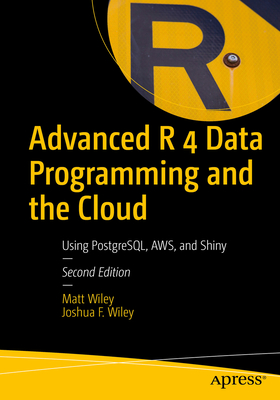Description
Program for data analysis using R and learn practical skills to make your work more efficient. This revised book explores how to automate running code and the creation of reports to share your results, as well as writing functions and packages. It includes key R 4 features such as a new color palette for charts, an enhanced reference counting system, and normalization of matrix and array types where matrix objects now formally inherit from the array class, eliminating inconsistencies.
Advanced R 4 Data Programming and the Cloud is not designed to teach advanced R programming nor to teach the theory behind statistical procedures. Rather, it is designed to be a practical guide moving beyond merely using R; it shows you how to program in R to automate tasks.
This book will teach you how to manipulate data in modern R structures and includes connecting R to databases such as PostgreSQL, cloud services such as Amazon Web Services (AWS), and digital dashboards such as Shiny. Each chapter also includes a detailed bibliography with references to research articles and other resources that cover relevant conceptual and theoretical topics.
What You Will Learn
- Write and document R functions using R 4
- Make an R package and share it via GitHub or privately
- Add tests to R code to ensure it works as intended
- Use R to talk directly to databases and do complex data management
- Run R in the Amazon cloud
- Deploy a Shiny digital dashboard
- Generate presentation-ready tables and reports using R
Who This Book Is For
Working professionals, researchers, and students who are familiar with R and basic statistical techniques such as linear regression and who want to learn how to take their R coding and programming to the next level.
About the Author
Matt Wiley leads institutional effectiveness, research, and assessment at Victoria College, facilitating strategic and unit planning, data-informed decision making, and state/regional/federal accountability. As a tenured, associate professor of mathematics, he won awards in both mathematics education (California) and student engagement (Texas). Matt earned degrees in computer science, business, and pure mathematics from the University of California and Texas A&M systems. Outside academia, he co-authors books about the popular R programming language and was managing partner of a statistical consultancy for almost a decade. He has programming experience with R, SQL, C++, Ruby, Fortran, and JavaScript. A programmer, a published author, a mathematician, and a transformational leader, Matt has always melded his passion for writing with his joy of logical problem solving and data science. From the boardroom to the classroom, he enjoys finding dynamic ways to partner with interdisciplinary and diverse teams to make complex ideas and projects understandable and solvable. Joshua F. Wiley is a lecturer in the Turner Institute for Brain and Mental Health and School of Psychological Sciences at Monash University. He earned his PhD from the University of California, Los Angeles and completed his post-doctoral training in primary care and prevention. His research uses advanced quantitative methods to understand the dynamics between psychosocial factors, sleep and other health behaviours in relation to psychological and physical health. He develops or co-develops a number of R packages including varian, a package to conduct Bayesian scale-location structural equation models, MplusAutomation, a popular package that links R to the commercial Mplus software, extraoperators for faster logical operations, multilevelTools for diagnostics, effect sizes, and easy display of multilevel / mixed effects models results, and miscellaneous functions toexplore data or speed up analysis in JWileymisc.

